Porchetta is one of Italy’s most famous pork dishes. Use this authentic Italian porchetta recipe to recreate the flavors of this traditional sandwich (panino) from Italy. Don’t be afraid, it’s easy to make porchetta!
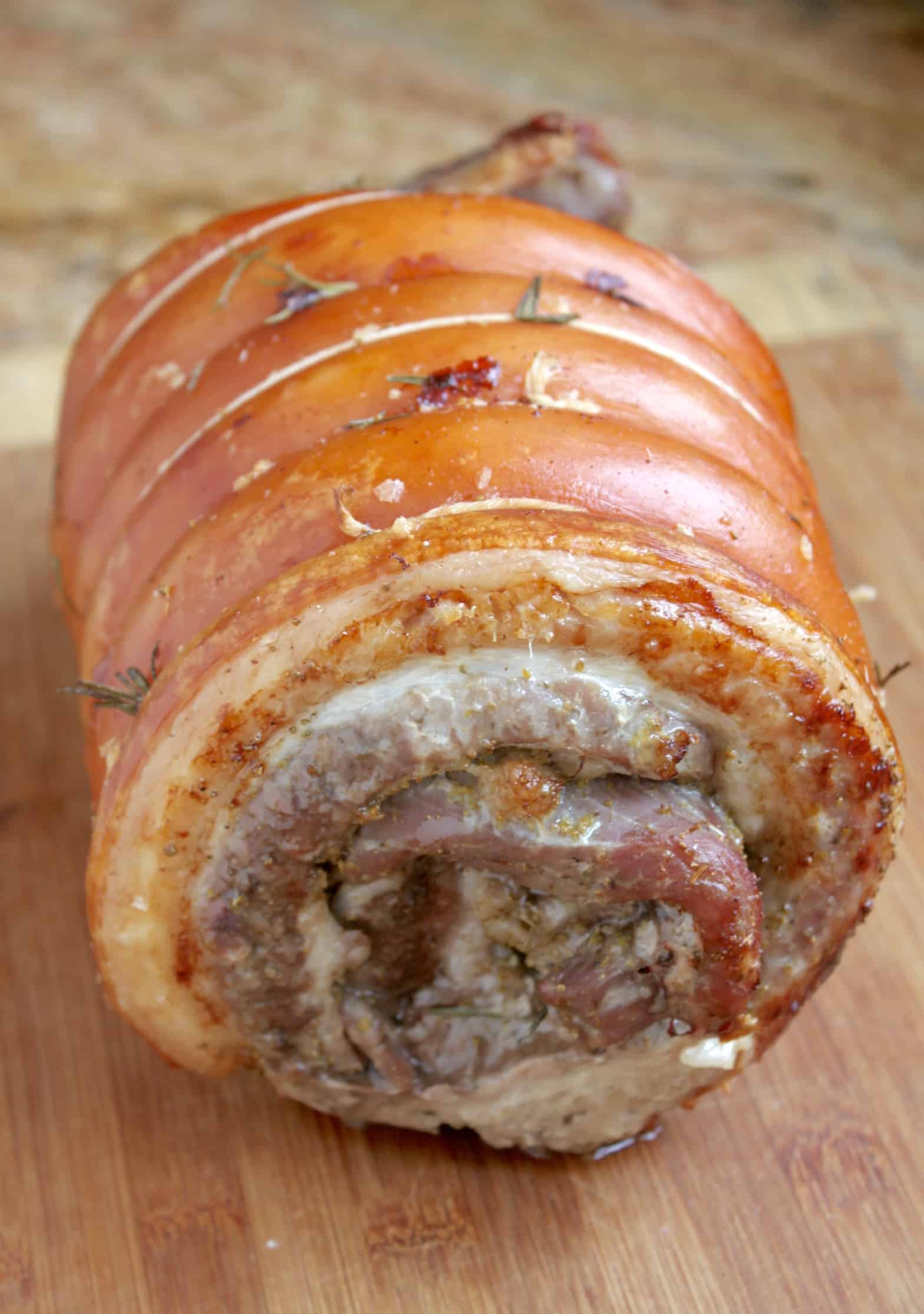
Visiting Italy frequently definitely has its pros and cons.
As an Amazon Associate I earn from qualifying purchases.
It’s easy to figure out the good points, but one of the downsides is that it only reinforces my high standards for Italian food and drink to the degree that I’m often disappointed elsewhere. (Thankfully, this porchetta and rapini panino in New Zealand passed the test, as did most of the food there.)

You may recall my post about visiting Orvieto from last year. If you do, you may also remember that I shared photos of the best porchetta panino that my mother and I had ever tasted, despite the bread having no salt in it whatsoever.

We were concerned we might not like the panino (because of the unsalted bread), but our trepidation was all for naught. After we took our first bite, we both looked at each other, and knew we’d make the right call! It was incredibly delicious, and so full of flavor. Mum and I still talk about that sandwich (from a butcher shop, of all places).

Luckily, I went inside after finishing every last morsel of that pork sandwich to ask details on how they made it. The primary flavoring was a lot of fennel pollen which they happened to sell in little test tube containers. I bought one with the intention of attempting to recreate this porchetta at home in Los Angeles, and I did!

The amount of fennel pollen in the test tube wasn’t nearly enough to season the size of my porchetta in the manner that the butcher in Italy had, but it was still phenomenal! To be fair, this is isn’t an inexpensive meal, although it will make a lot of servings if you use an 8-10 lb piece of pork.
You’re probably sick of hearing me say this, but I can’t not say it: the quality of the handful of ingredients used for this porchetta is the key to outstanding results. Porchetta is easy to make, but you need the proper ingredients.
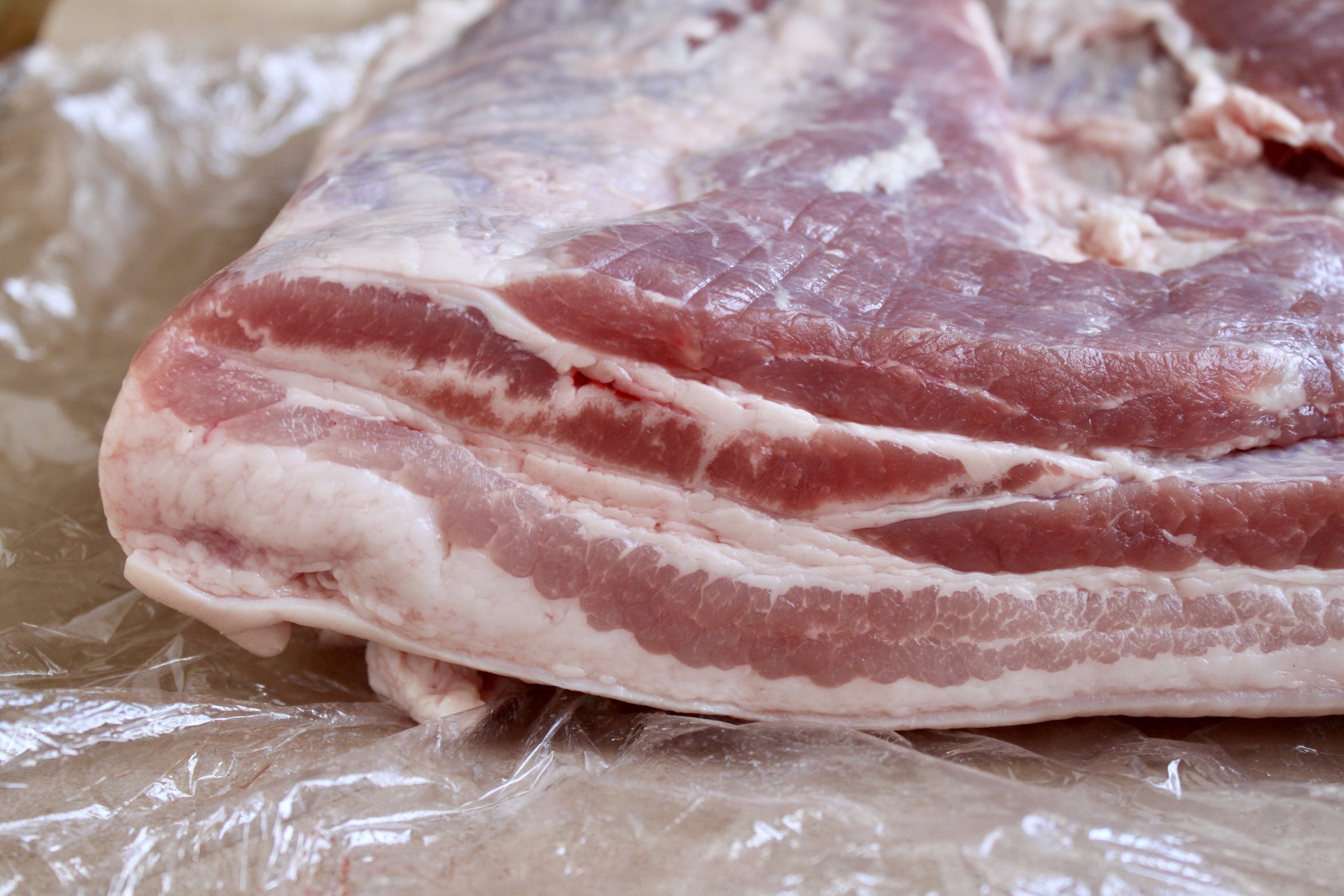
This is the most important part of the recipe–honest–buy good meat. I bought my pork at McCall’s Meat and Fish in Los Feliz (Los Angeles). Scroll down for the printable recipe if you don’t need to know any more about porchetta.

Love all things “pork”? Try this nose to tail style Italian cotechino sausage recipe.
What is Porchetta?
Literally translated, porchetta means “little pig”. In Italy, porchetta can refer to a roasted whole suckling pig, an older pig, or just the pork belly roll, “porchetta tronchetto” (which is what I’ll be showing you how to make). No matter what type of porchetta, there is always one common thread: the rind is always included.

What Cut of Meat is Used for Porchetta?
Pork belly is used in making this type of porchetta (when it’s not a whole suckling pig). The butcher will cut it so that it’s ready for you to roll into shape, if he/she is familiar with porchetta. You may be advised to use a different cut of pork, but this is not going to give you the same results. Italians know what they’re doing with their traditional dishes; advice from non-Italian sources will often lead you astray.
Add this to next week’s dinner menu: breaded pork schnitzel.
Is Porchetta the Same as Pork Belly?
No, as stated above, porchetta can be an entire pig, so sometimes it’s not the pork belly. However, if it’s pork belly, part of the loin is included, too.
What is the Difference Between Porchetta and Pancetta?
As described above, porchetta is a type of roast pork, but pancetta is cured pork belly. Porchetta is cooked, pancetta is cured. You can read my post on how to make pancetta, too.
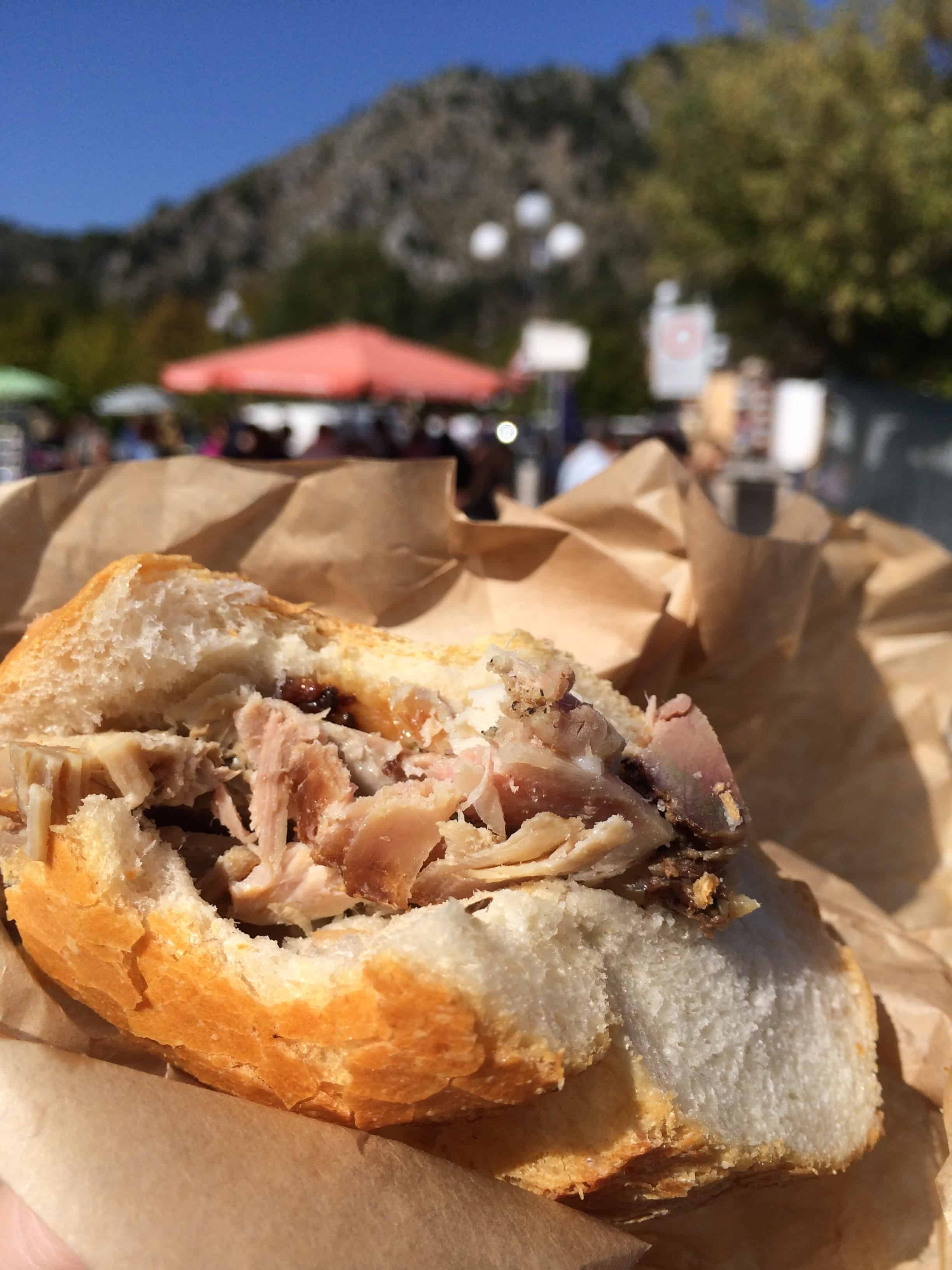
What do Italians eat with Porchetta?
When I saw the misinformation given on another website, I imagined that this person has never even been to Italy! Porchetta is normally served on bread, in a panino with nothing else! No sauces, lettuce, tomato, pickles, salsa verde, chimichurri, or side dishes. NOTHING. This is because the flavor of the pork is so insanely good, that’s what they want to taste! It makes so much sense when you realize how flavorful everything is.

When it comes to serving porchetta in a panino (sandwich, one Italian website about porchetta wrote something loosely translated to this: “We recommend not to make any “Americana” like putting barbecue sauce on the sandwich.” I concur, and advise you not to add anything else with the porchetta in the bread. Just resist the temptation and see what you think! (If you use this recipe for porchetta and use good quality ingredients, you won’t need anything in your sandwich.)
What to Serve with Porchetta
What to serve with porchetta? Absolutely nothing but bread! If you want to keep it authentic, do not serve porchetta with any side dish.
What Type of Bread is Used with Porchetta?
As long as you use a really good quality, Italian-style bread, you’ll be fine. If you are in certain parts of Italy, porchetta is served in a panino/sandwich using their unsalted bread (like the one I had in Orvieto). However, the most important thing about the bread is that it’s either homemade or very good quality. An Italian site recommends, that this “street food delight” is “to be eaten standing up only”. However, their most critical requirement is that homemade bread is used.

How to Make Porchetta?
Glad you asked! It’s truly super easy, and only takes a minimal of ingredients and a few steps! Weights and amounts are not critical, so please don’t stress on exact amounts.
Is Porketta the Same as Porchetta?
There is no such word as “porketta”; it is “porchetta” spelled incorrectly. Ch in Italian sounds like “k”.
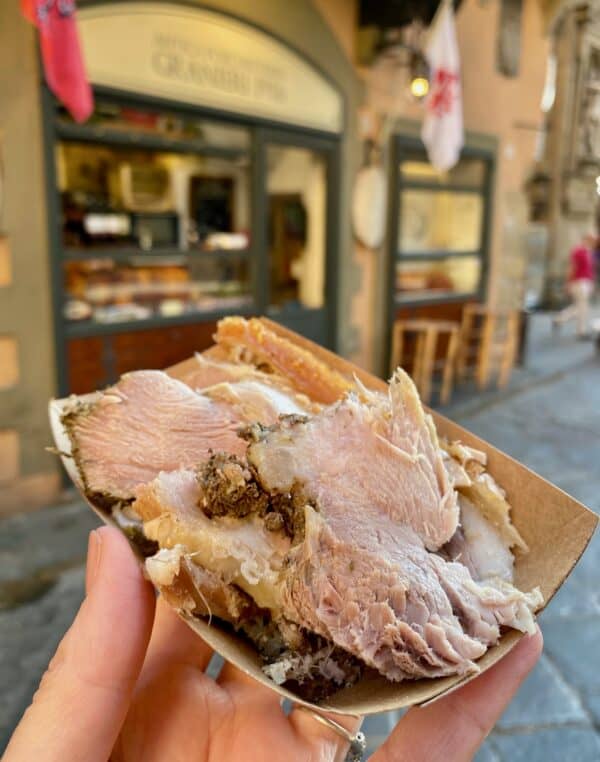
Do I need Fennel Pollen to Make Porchetta?
It really is a key ingredient to make it in an authentic Tuscan Italian manner, but it’s expensive and may be difficult to find. There really is no substitute since fennel/fennel seed and fennel pollen taste very different from one another. I managed to find this wild Tuscan fennel pollen at a gourmet shop near me. I’ve linked to a famous butcher’s brand below, but this one is a bit more and almost twice as much organic fennel pollen.

NB: don’t be tempted to add garlic. This is speculation on my part, but I think garlic is more of an American Italian addition. I’ve never tasted garlic in porchetta in Italy, however, it might be used in some other areas where I’ve not visited (but then they’re not famous for their porchetta). It definitely wasn’t in the porchetta from Orvieto,
Pork, Pickled Peppers and Potatoes – another authentic Italian recipe to try.
Isn’t this a thing of beauty?

Authentic Italian Porchetta Recipe
FULL PRINTABLE RECIPE BELOW
Inspired by Bottega Roticiani Butcher in Orvieto serves about 20 or more
FULL PRINTABLE RECIPE BELOW
Ingredients
- one fresh, pork belly roast with the skin (ask your reputable butcher) weighing 8 to 10 lbs
- Kosher or sea salt (I used Maldon)
- fresh or dried rosemary
- wild Tuscan fennel pollen (if you can source it) at least 1 oz, but as you can see, more is better in this case (it is expensive, though) this brand is from Italy’s most famous butcher, (but I bought some locally at a much more reasonable price)
- freshly ground black pepper
- good quality extra virgin olive oil
Special equipment: butcher’s twine and a large tray with rack
Crusty Italian bread or rolls (panini) for serving
Prepare the Meat
Open the piece of pork onto the butcher paper or clean countertop, skin side down.

Sprinkle generously with the salt.

Then work the salt into the pork.

Next, add the rosemary. We used fresh rosemary as I have a bush in my garden. Whether you use dry or fresh, rub it and crush it between your fingers to release the flavor and/or oil.

Add the freshly ground black pepper all over the porchetta.

Now add the fennel pollen. Sprinkle evenly over the pork, but save a little of the pollen for after the porchetta has been rolled.

Roll the Pork Belly and Tie it.

Roll it tightly.
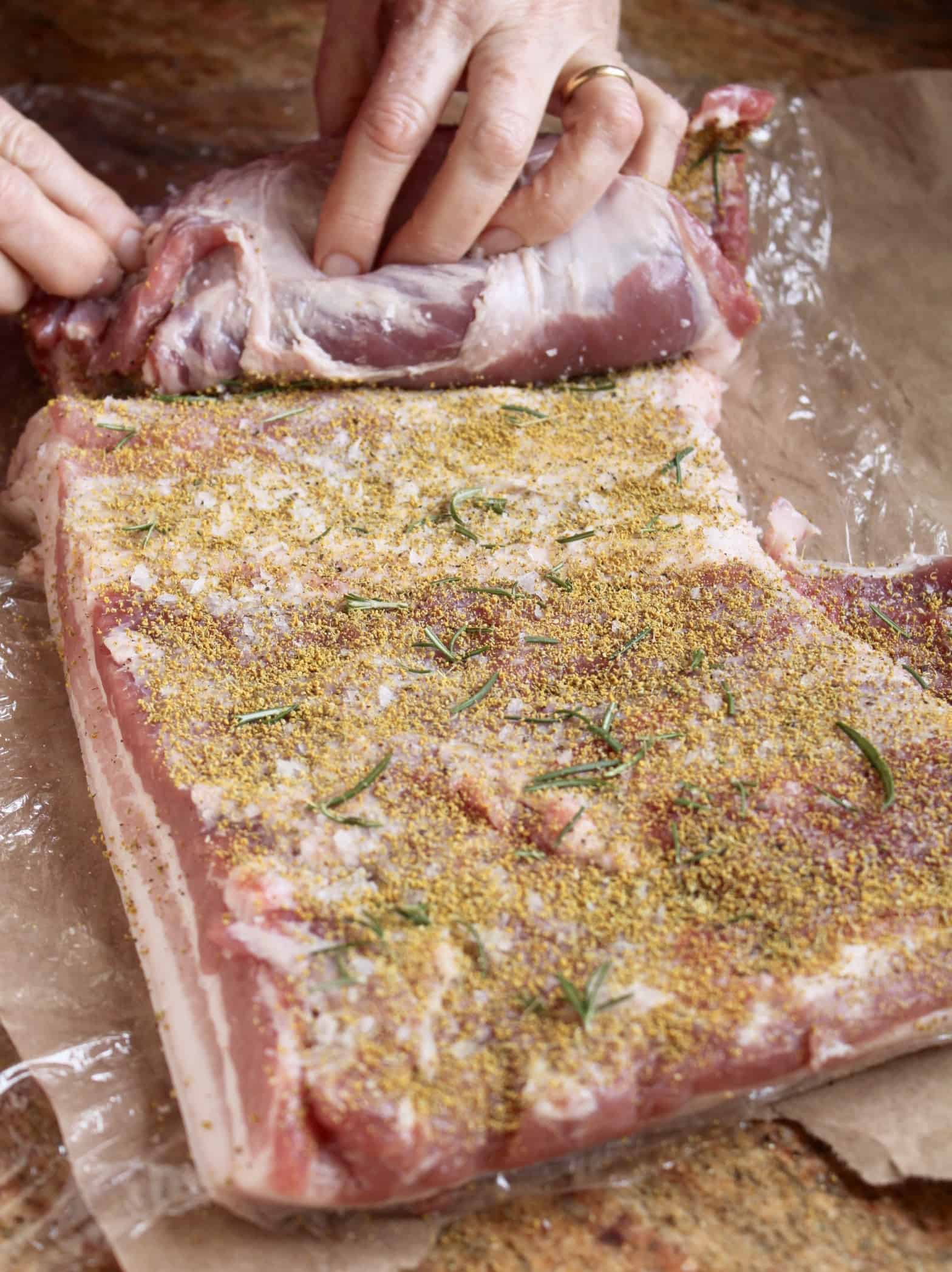
But as you roll it, sprinkly some salt onto the unseasoned side of the pork.

Continue rolling.

Until you reach the end.

Keeping the seam side down, start tying the pork. Another pair of hands will make this part immensely easier. There’s no need for fancy ties or sailors’ knots, just wrap, double knot and cut.

Repeat every few inches. The goal is only to keep the porchetta closed, so don’t tie it too tightly, either. As you can see, ours is far from perfect, but unless you’re serving the Queen of England, it won’t matter.

Finish the Preparation and Roast.

Turn the roast seam side up and add more seasonings, including the rest of the fennel pollen to the non-skin parts of the pork which are exposed (including the ends).

Place seam side down on a rack on a roasting pan or baking tray. Cover the ends with aluminum foil and secure with toothpicks.

Drizzle with olive oil and rub all over the skin with your hands. Sprinkle with more salt and rosemary.

Preheat the oven to 400˚F (200˚C).

Place in the hot oven when it comes to temperature and roast for 1 hour, then lower the temperature to 350°F (170°C) and continue to cook for about another 2 hours. Check the center of the roast when it reaches 170°F (76°C) remove from the oven. Take the foil off the ends and place on top of the porchetta, and allow to rest for about 10 minutes.

Using a sharp knife, remove one or two of the pieces of twine.
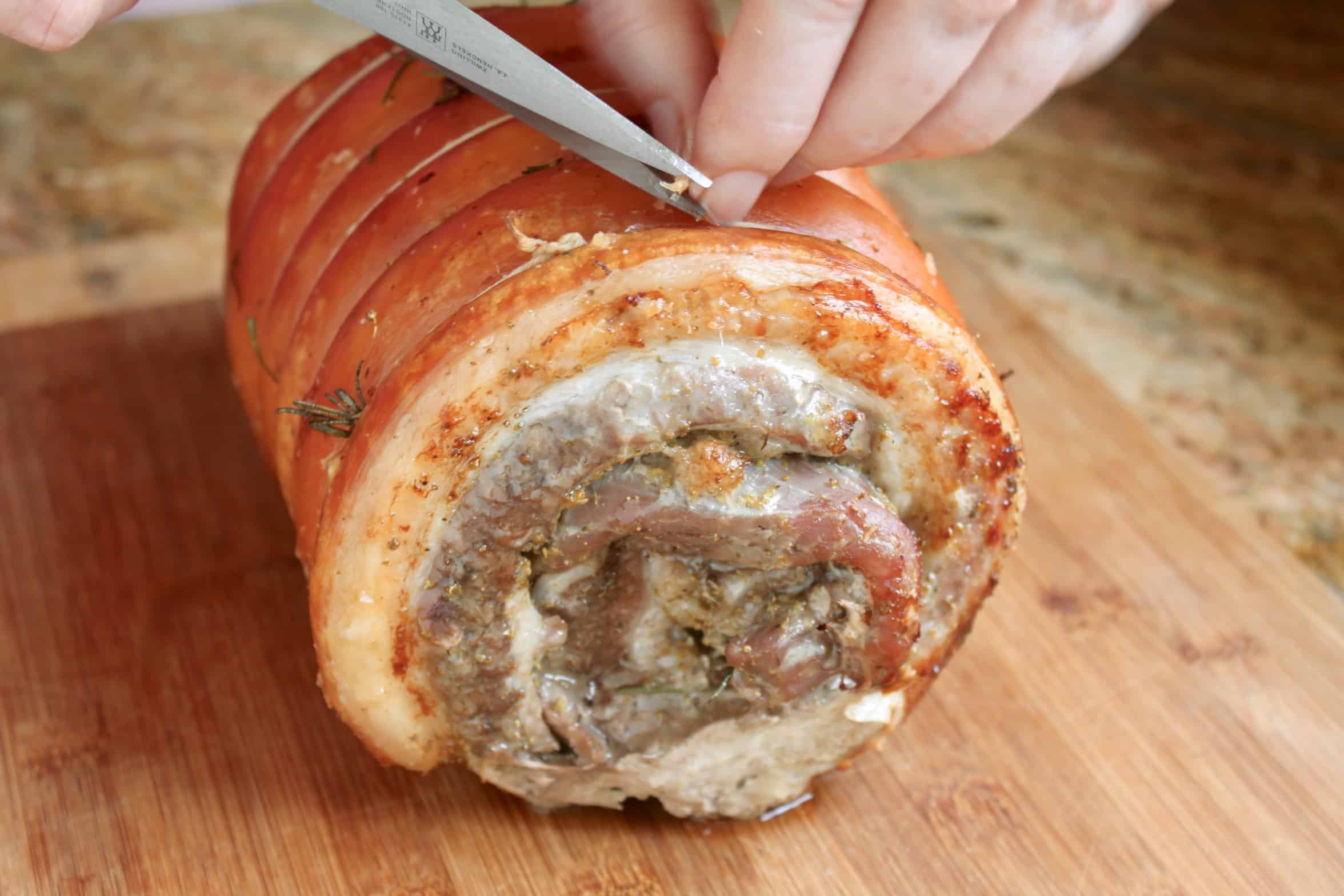
Cut into slices and serve on crusty Italian rolls, or bread, Italian style!

Buon appetito!

If you make this, please let me know!

Try my pork schnitzel recipe, too!


Porchetta (Authentic Italian Pork Roast)
An authentic Italian porchetta recipe.
Ingredients
- 8 to 10 lbs fresh porchetta roast with the skin
- Kosher or sea salt (I used Maldon)
- fresh or dry rosemary
- wild Tuscan fennel pollen (see notes)
- freshly ground black pepper
- good quality extra virgin olive oil
- crusty Italian bread rolls for serving
Instructions
Prepare the Porchetta
- Open the piece of pork onto the butcher paper or clean countertop, skin side down.
- Sprinkle generously with the salt, then work the salt into the pork.
- Next, add the rosemary. We used fresh rosemary as I have a bush in my garden. Rub it and crush it between your fingers to release the oils.Add the freshly ground black pepper all over the porchetta. Now add the fennel pollen. Sprinkle evenly over the pork, but save a little of the pollen for after the porchetta has been rolled.
Roll the Pork Belly and Tie it.
- Roll it tightly, but as you roll it, sprinkly some salt onto the unseasoned pork. Continue rolling until you reach the end.
- Keeping the seam side down, start tying the pork. Another pair of hands will make this part immensely easier. There's no need for fancy ties or sailors' knots, just wrap, double knot and cut.
- Repeat every few inches. The goal is only to keep the porchetta closed, so don't tie it too tightly, either. As you can see, ours is far from perfect, but unless you're serving the Queen of England, it won't matter.
Finish the Preparation and Roast.
- Turn the roast seam side up and add more seasonings, including the rest of the fennel pollen to the non-skin parts of the pork which are exposed (including the ends).
- Place seam side down on a rack on a roasting pan or baking tray. Cover the ends with aluminum foil and secure with toothpicks.
- Drizzle with olive oil and rub all over the skin with your hands. Sprinkle with more salt and rosemary.
- Preheat the oven to 400˚F (200˚C).
- Place in the hot oven when it comes to temperature and roast for 1 hour, then lower the temperature to 350°F (170°C) and continue to cook for about another 2 hours. Check the center of the roast when it reaches 170°F (76°C) remove from the oven. Take the foil off the ends and place on top of the porchetta, and allow to rest for about 10 minutes.
- Using a sharp knife, remove one or two of the pieces of twine. Cut into slices and serve on crusty Italian rolls, or bread, Italian style!
Buon appetito!
Notes
- Special equipment: kitchen twine and a large tray with rack
- If you can source it, use at least 1 oz of fennel pollen as you can see from the photo in Orvieto, more is better in this case (it is expensive, though) this brand is from Italy's most famous butcher
Nutrition Information:
Yield: 20 Serving Size: 4 ozAmount Per Serving: Calories: 250Total Fat: 15gSaturated Fat: 1gTrans Fat: 0gUnsaturated Fat: 2gCholesterol: 3mgSodium: 48mgCarbohydrates: 1gFiber: 0gSugar: 0gProtein: 1g
Nutrition information is only estimated
Christina’s Cucina is a participant in the Amazon Services LLC Associates Program, an affiliate advertising program designed to provide a means for sites to earn advertising fees by advertising and linking to Amazon.com.


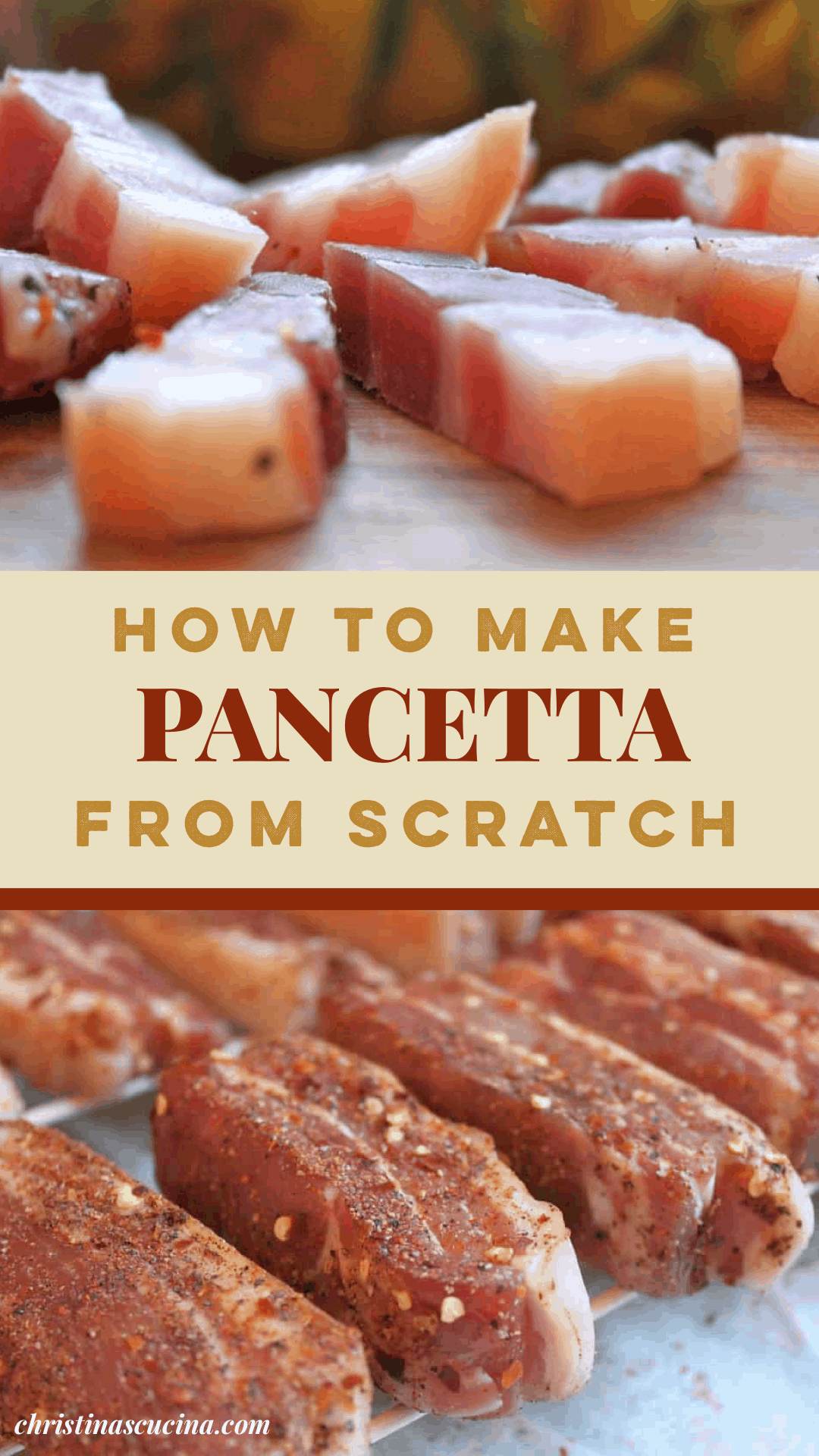





I’ve used your recipe before, but thinking about it I don’t know the amount of each ingredient I used. I found your recipe again online, but you don’t include the amounts of each ingredient in your recipe. At least not that I can find. I assume I generously coated it, but I feel like I need the amounts to follow the recipe correctly. Can you possibly add the amounts or tell me here please?
Sincerely,
Lisa
Hi Lisa, sorry I don’t have amounts, but for something like this, it’s really difficult due to the size and thickness of the pork, the type of salt used, etc. As you can see in the photos, we’ve just coated the pork in a thin layer of salt and seasonings, but I do mention 1 oz of fennel pollen as it’s an expensive item outside of Italy. If you can add 2 oz or more of fennel pollen, I would do it. You can see the photo of the porchetta in Italy, there is so much fennel pollen in there.
If you made it before, trust your gut because you are most likely going to do the same that you did again. I hope this helps! Lmk, and good luck.
Did you butterfly the roast?
No Barb, the butcher prepped it for me, so it was (literally) ready to roll.
[…] Porchetta traces its origins to the heart of the broader Lazio region, where it has been a staple of culinary tradition for generations. This iconic dish centers around meticulously seasoned pork belly and pork loin. They are are then slow-roasted to achieve a succulent interior and a crispy exterior. The fusion of olive oil and black pepper, among other seasonings, create a savory flavor profile deeply embedded in every bite. The resulting texture, a delightful contrast between tender meat and crackling skin, makes porchetta a truly indulgent experience. The methodical preparation of bake porchetta, particularly its fat content and robust seasoning, calls for a thoughtful approach to the right pairing. Variety of wines with high acidity or bright acidity come into play here, harmonizing with the richness of the dish to cleanse the palate. […]
Fennel grows prolific here (NZ) and right now it’s summer and fennel is fully in yellow flower/pollen
So went out for a bike ride and foraged about 30g easily of wild pollen :)
Porchetta is in the fridge for tomorrow cook
Oh my goodness, I LOVE this! Let me know how it turns out! I’m curious about using it fresh, too!
I am making this recipe fora lunch this week, what would you recommend to serve with this, I was thinking duck roasted potatoes, a witlof salad and may be roasted baby tomatoes with buffalo mozzarella with pesto, what are your thoughts/ my friends are real foodies1
Hi Marg, if serving it Italian style, just bread (in a panino). However, if serving like a pork roast, then I think the roasted potatoes and a simple green salad sounds good!